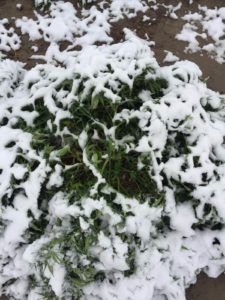
(Photo courtesy of Trilogene Seeds)
(A version of this story appeared earlier on Marijuana Business Daily.)
An early cold snap that swept through Colorado this week drove temperatures below freezing and dumped inches of snow, potentially destroying valuable hemp plants nearing harvest.
The crop damage also hit outdoor-grown marijuana and will likely disrupt the supply of material for THC and CBD extracts across the state for months to come, similar to what happened when southern Colorado experienced an early freeze in October 2019 that caused significant financial losses to large outdoor marijuana farms.
That freeze also curbed the usual flood of outdoor-grown cannabis into the state’s market.
As opposed to last year, a Colorado temperature swing of roughly 70 degrees Fahrenheit came far too early in the season for growers to preemptively harvest their plants.
Dr. Jon Vaught, CEO and co-founder of Front Range Biosciences, a Lafayette, Colorado-based cannabis biotech firm with hemp growing operations, said the storm was “catastrophic for growers.”
“This is devastating,” he added.
‘Tough struggle’
In the San Luis Valley, near the small town of Moffat in southern Colorado, hemp grower Harvey Craig said temperatures were in the high 20s Wednesday morning.
“Anything that was left outside froze pretty solid,” he added.
Greenhouses cover about 70% of Craig’s hemp farm, and he used shade cloth, canvas and plastic to protect the rest of the outdoor plants.
Plastic can stop the growth of flower, according to Craig, “but it’s better than nothing.”
Wet and heavy snow snapped uncovered plants at the stalk and broke branches.
Intact plants might still lose cannabinoids if the snow and frost knocked off trichomes.
“This is devastating to a lot of farmers,” Craig said, echoing Vaught. “I hope this doesn’t put people over the edge. The hemp industry is a tough struggle.”
Craig said he skipped crop insurance this year. He’s had problems with insurance companies not wanting to work with hemp.
As for the impact to the CBD supply in the region, while the storm’s impact on large-scale industrial outdoor farms could cause a dip in supply, Craig said thousands of pounds of dried flower from last year still haven’t been extracted.
30% losses
Matt Haddad, CEO and founder of Trilogene Seeds, a hempseed production company based in Longmont with partner farms throughout the state, said temperatures dropped to around 26 degrees in the San Luis Valley.
Greeley was a little warmer at around 30 degrees, but Haddad said that area saw 6-8 inches of snow, which broke branches and weighed down plants.
Workers there staked up the hemp while trying not to damage the root system. Haddad said about 30% of the plants in a 26-acre field were hurt by the snow.
He estimates that about 20-30% of his crop was lost or damaged, though he expects trichome production and cannabinoid content to recover.
“I think we’ll be OK,” Haddad said. “Luckily it was really just that one day.”
Planet instability
Tim Gordon, chief science officer at Functional Remedies, based in Boulder with a hemp cultivation operation east of Pueblo, said he hasn’t experienced anything like this storm.

A close-up look at a snow-covered plant at the Functional Remedies hemp farm outside Pueblo, Colorado. (Photo courtesy of Tim Gordon)
“The sudden onslaught was unprecedented,” he said.
Temperatures at the Pueblo farm were around 32 degrees Fahrenheit early Wednesday morning but didn’t get lower.
His seven-person farm crew, along with five seasonal workers, walked the 60-acre hemp farm shaking the snow off branches and trying to lift up plants that were pushed to the ground.
His farm was in the harvest-preparation stage, with the plants fully flowering and nearing maturity.
The freeze could cause damage to the cell structures of the plants as well as kill off fan leaves. The moisture could lead to bud rot if the plant doesn’t dry out.
“There’s potential for a complete loss,” Gordon said.
Fortunately for Functional Remedies, the company has crop insurance with an act-of-god clause.
Vaught said the growers with healthy, vigorous plants are better positioned to withstand these types of storms.
He recommends paying attention to fertigation and irrigation systems, keeping backup power generators tuned up, and making sure gas connections are set up to keep the heating system prepared.
“Anything you can do to minimize the stress,” Vaught said.
But he recognizes that outdoor growers don’t have the same options.
For them, he recommends certain strains, such as like Early Pearly, that can survive frost and slightly lower temperatures than other cultivars. Those are particularly useful in the spring if a late freeze hits.
Broadly speaking, Vaught pointed out that the weather extremes will continue to be a challenge for anyone growing plants outdoors.
“This is direct evidence of the variability of climate change,” Vaught said. “It makes it very hard to navigate in an agricultural setting.”
Bart Schaneman can be reached at [email protected]

